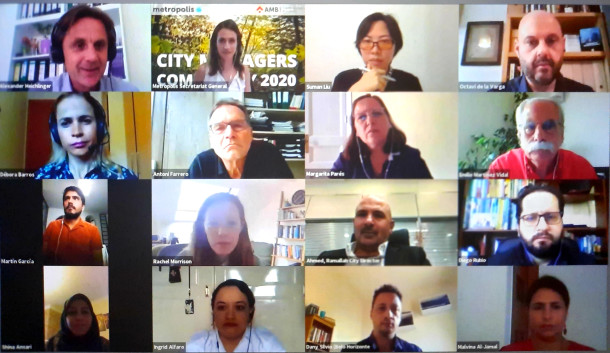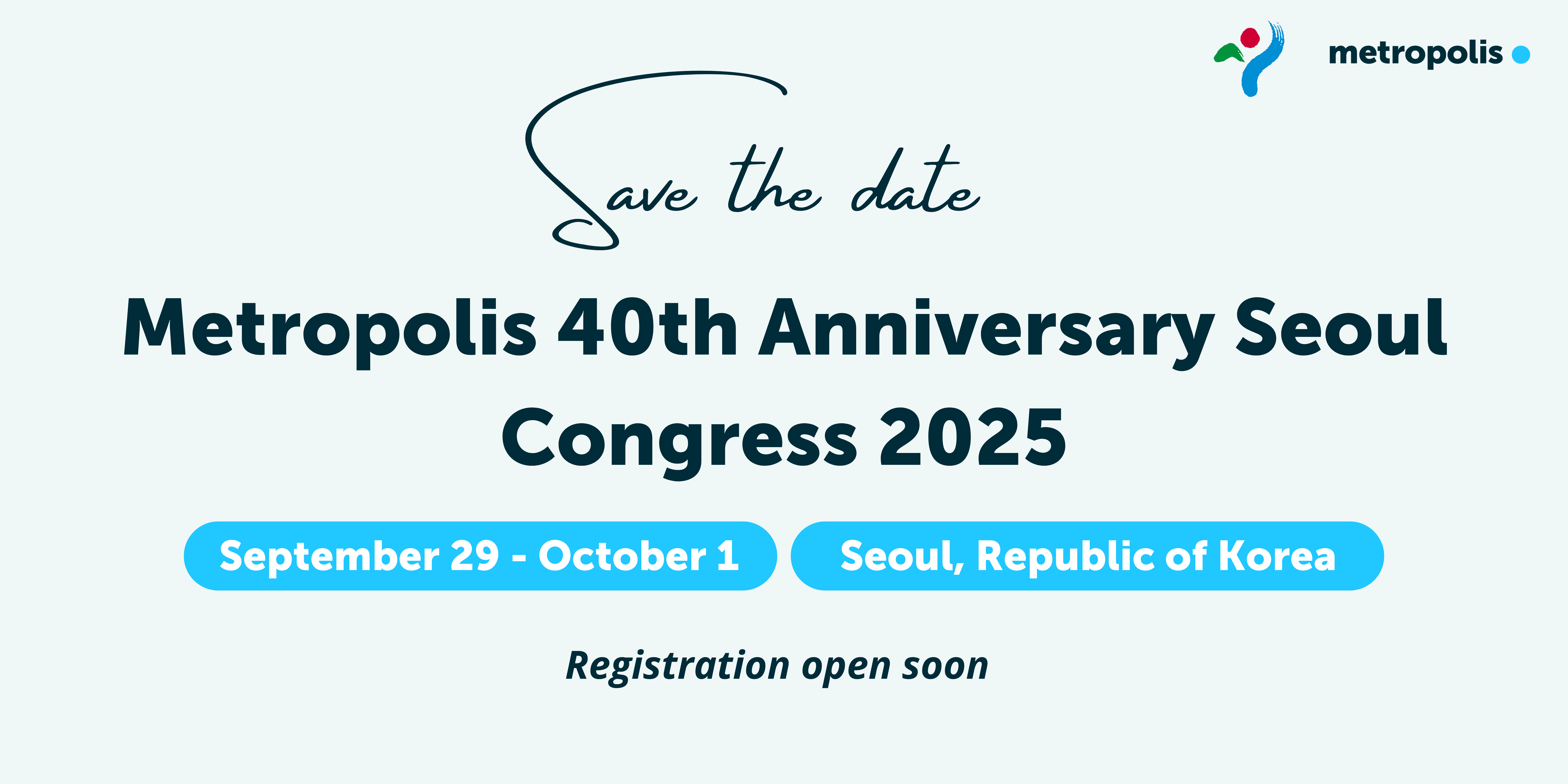
Green infrastructure: connecting metropolitan spaces and paving the way for sustainable development
Leaders in charge of the day-to-day management of green spaces in 15 major metropolises share innovative solutions to problems that single-purpose ‘grey’ infrastructure is unable to tackle
The Metropolis City Managers Community resumed its activities in 2020 with a webinar organised on 16th July, which brought together 15 top leaders from our membership who are in charge of the day-to-day management of green infrastructure. Learning about the various forms, functions, scales, and impacts that green infrastructure can have in major metropolises was the focus of the meeting, which set the path to the project’s next activities, scheduled for November.
Green infrastructure arises as a great source of innovative solutions to tackle many of the challenges that our urban societies are facing today. From better air and water quality to the control of diseases, green infrastructure has the potential to provide integrated solutions resulting in environmental, economic and social benefits. Its strategies and approaches may include a broad scope of initiatives, such as green roofs or walls, reed-beds, urban gardens and forests, ecological corridors and others, which can be implemented in combination with zoning, mobility, housing and civic engagement plans, in order to obtain optimal results. At metropolitan scales, green infrastructure can reach the magnitude required to respond to climate change emergencies and to improve the quality of life of vast urban populations.
"This is a safe environment to exchange ideas with each other”, Octavi de la Varga, Metropolis Secretary General
Exclusive to the representatives of the Metropolis membership who took part in a survey named “Green Infrastructure Metropolitan Portrait” (open from 11 June to 6 July 2020), the online session offered to a group of peer officials from Barcelona (metropolitan area and municipality), Belo Horizonte, Bogotá, Cairo, Chengdu, Ciudad de México, Greater Manchester, Guadalajara, Madrid, Montréal, Ramallah, Rio de Janeiro, San Salvador, and Tehran, an opportunity to get to know each other for the first time, get to know the findings of the survey, and exchange information about their green infrastructure flagship projects. “This is a safe environment to exchange ideas with each other”, said our Secretary General, Octavi de la Varga, during the webinar’s opening remarks.
Alexander Heichlinger, Senior Expert and Consultant in city management who is in charge of the dynamization of all activities of the City Managers Community this year, moderated the discussion and shared the first insights from the survey, which indicated that the majority of members count on a dedicated department/unit on green infrastructure, and also on a political strategy supported by a regulatory framework to allow its implementation. Most of the participating members also indicated that their definition of green infrastructure is related to ecosystem services and natural spaces. The prevailing types of green infrastructure informed by members are fresh air corridors, parks and green spaces.
The survey also confirmed a trend already identified through our system of metropolitan indicators: that green space per inhabitant varies a lot among Metropolis members, ranging from 1 to 102,1 square meters per inhabitant according to the responses received, which refer to city, metropolitan and national scales (whereas according to data at the metropolitan scale available for 82 of our members, the range is from 91 square centimeters/inhabitant to 32 square meters/inhabitant, resulting on an average of 4.35 square meters of green space per inhabitant). The data obtained from the survey with the City Managers Community provided further insights on the distribution and location of these green spaces: in most cases, they are scattered throughout the urban territory, although in some cases, they are concentrated at the periphery. Last but not least, the survey also indicated the prominence of collaboration with different sectors of society (mostly private companies, followed by academia, civil society organizations and individual citizens) in order to develop “greener” metropolises.
The webinar also featured presentations of flagship projects by six “City managers” of the group:
- Antoni Farrero, General Coordinator of the Technical Office of the Metropolitan Area of Barcelona, explained how the socio-environmental recovery of the Llobregat River is taking place, as a key process in the connectivity of the metropolis. The river crosses 14 municipalities in the metropolitan area and is surrounded by a high density of various infrastructures: highways, trainways, housing, and agricultural lands, just to name a few. “We can’t go back to previous models, but we must establish new models under modern and real conditions", he said, showing the commitment of the metropolitan authority to projects that are resilient to climate change and that implement nature-based solutions.
- Liu Suman, Deputy Division Chief of Foreign Affairs Office of Chengdu Municipal Government, introduced the Park City Initiative, which is promoting healthier lifestyles to 16 million inhabitants, through the consolidation, until 2030, of green areas every 300 meters across the city’s territory.
- Débora de Barros Augusto, Green Areas Coordinator of the Rio de Janeiro Municipality, told the story of Mutirão Reflorestamento, a program initiated more than 30 years ago, which is based on a community task force for the reforestation of the city. So far, more than 3400 hectares of green areas have been recovered, with 10 million seedlings planted. Nowadays consolidated as regional policy, not only does the program help to control the expansion of informal settlements, prevent landslides and increase local biodiversity but also it provides direct income to over 600 people from vulnerable communities.
- Emilio Martínez Vidal, Senior Advisor of the Strategic Planning Direction of the Madrid Municipality, brought the case of the Madrid Metropolitan Forest, a 75 km peripheral green belt to improve biodiversity conservation and air quality in the metropolis, as well as its social cohesion and quality of life. The project will connect already existing parks and corridors to integrate the metropolitan city through the different perspectives of citizens’ daily lives. “Trees and forests ensure that our city is economically, socially and environmentally more sustainable and resilient”, he said.
- Ahmed Saad, Undersecretary in the field of infrastructure at the General Organization for Physical Planning (GOPP) of the Egyptian government, explained Cairo's experience using green infrastructure to rationalize the consumption and management of available water resources, which reduced the losses of drinking water from 34% in 2014 to 26% in 2019.
- Guy Trudel, Project Urban Designer of the City of Montréal, explained how the bioretention systems of the Papineau Avenue work: along the city’s longest north-south street, soil beds planted with native vegetation control stormwater runoff, countering the heat island effect and increasing biodiversity. Along these corridors, the project allowed the creation of pedestrian pathways, which ensure, in addition, human-scale and healthy access to the neighborhoods that are crossed by the avenue.
The City Managers Community will get together again in November 2020, for the celebration of the 5th edition of the City Managers Days, in the framework of the Smart Cities Live 2020. Organized 100% online for the first time, this edition of City Managers Days will feature the following activities:
- One session open to all the public of the congress, during which our members can showcase their flagship initiatives on green infrastructure, along with the release of the 12th edition of our collection of issue papers, which will be about the same subject
- One interactive workshop, exclusive to the community members
- One “live” field visit to a flagship project of the Metropolitan Area of Barcelona
Further updates and details about the next activities of the City Managers Community are soon to be published on the Metropolis agenda.
Download all the presentations of the webinar here:
- Alexander Heichlinger
- Antoni Farrero
- Liu Suman
- Débora de Barros Augusto
- Emilio Martínez Vidal
- Ahmed Saad
- Guy Trudel
For further information about the City Managers Community, please contact Lia Brum, Metropolis Observatory Officer at the Secretariat General

